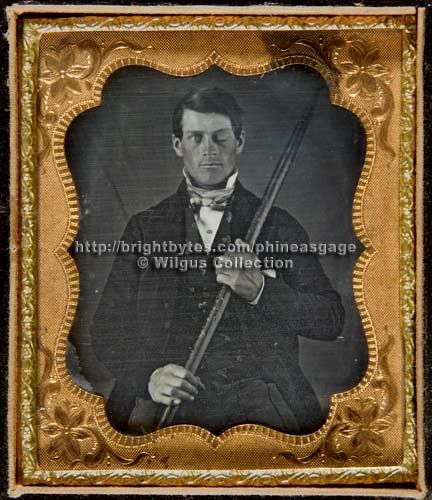Photograph collectors in Maryland have discovered what appears to be the only known photograph of Phineas Gage. Gage is a legend in neuroscience and psychology. Here's why (from the Boston Daily Courier, September 20th, 1848):
Horrible Accident. Phineas P. Gage, a foreman on the Rutland Railroad at Cavendish, Vt., was preparing for a blast on Wednesday last, when the powder exploded, carrying through his head an iron instrument, an inch and a fourth in circumference, and three feet and eight inches in length. The iron entered on the side of his face, shattering the upper jaw, and passing back of the left eye, and out the top of his head. Singularly enough, he was alive at two o'clock the next afternoon, in full possession of his reason, and free from pain (Macmillan, 1986, p. 77).
In many ways, the story of Phineas Gage has grown into a myth, and the legend surrounding Gage's condition probably began with the newspaper article above. There is still a pervasive view that Gage recovered fully from his injuries in a very short period of time. While it was amazing that Gage survived having a tamping iron travel through his brain, by no means was he ever the same person following the accident. For more information on Phineas Gage, I suggest you track down two great articles penned by Malcolm Macmillan at the University of Melbourne:
- Macmillan, M. B. (1986). A wonderful journey through skull and brains: The travels of Mr. Gage's tamping iron. Brain and Cognition, 5, 67-107.
- Macmillan, M. (2008). Phineas Gage - Unravelling the myth. The Psychologist, 21, 828-831. (link)
h|t BPS Research Digest








4 comments:
I could swear I've seen photographs of him before--but maybe that's like the Tucson Epitaph cowboys and the pterodactyl photo that people seem to think they've seen, where the newspaper story exists, but there is no photo. I've read some pretty vivid descriptions of Gage's story, as well as seen dramatic re-enactments (e.g., in the PBS series _The Brain_--or was it _The Mind_, I get those two confused).
I always imagined Gage to be a little oafish, so based on this image, I don't think I've ever seen a picture of him before.
Researchers such as Malcolm Macmillan and I hope readers can contribute to a fuller picture of Phineas Gage by helping answer questions such as those below. Many relate not to Gage directly, but rather to people he met or places he’d been. FOR MORE SPECIFIC QUESTIONS, and how the answers might help us better understand Phineas, please visit www.deakin.edu.au/hmnbs/psychology/gagepage/PgQuestn.php .

Information might be in letters and diaries; medical and business records; town, police and court files; local newspapers; or in the archives of churches, hospitals and literary, professional, historical and genealogical societies. We especially hope organizations will search their one-of-a-kind materials not published in book form.
IN CHILE (1852-60): We want to know about Drs. William and Henry Trevitt, Masonic lodges, Methodist churches, and English-language newspapers, schools and businesses. Do you know anyone who can help with such things?
IN NEW ENGLAND (1848-54): Can you find newspaper or diary accounts of Phineas’ accident, of his travels exhibiting himself and his “iron,” or of his reported preaching at Methodist revivals in Sterling, Mass.? In Concord, NH records of the Abbot-Downing coachworks could identify “three enterprising New Englanders” who may have set up the coach line for which Phineas drove in Chile; in Hanover you might discover Phineas’ duties at Currier’s Inn, or a Dartmouth professor who met him; and somewhere in Wilton may be the papers of Henry Trevitt.
IN CALIFORNIA (1860- ): Where is the missing undertaker’s ledger showing where Gage died? What can you discover about Dr. William Jackson Wentworth (Alameda Co.) or the papers of Joseph Stalder (d.1931)? Are you descended from Phineas’s nieces/nephew Hannah, Delia, Mary, Alice, or Frank B.Shattuck? Can we learn more about Frank at the School for the Deaf?
IN OHIO (1860- ): Can you find anything about Henry Trevitt’s time at Starling Medical College in Columbus, Prof. J.W. Hamilton, or William Trevitt’s papers?
ANYWHERE: If you are related to the Cowdrey, Davis, Ames, or Kimball families, are you also related to Phineas’ doctor, John Martyn Harlow? Do you know of ship passenger lists (Boston, New York, Chile, Panama, S.F.) that might show Gage family movements? Do you have Gold Rush ancestors who stopped in Valparaiso, Chile? And of course, letters mentioning Gage could have gone anywhere.
There are more clues in Stillwater and Northfield, MN; Santa Clara, San Rafael, and S.F., CA; Cavendish, Castleton, Woodstock, and Burlington, VT; Lebanon and Enfield, NH; Albany, NY, Buda, IL, the National Library of Medicine, and other places. At www.deakin.edu.au/hmnbs/psychology/gagepage/PgQuestn.php are details on how you can help by following such clues. Your help or inquiries to malcolm.macmillan@unimelb.edu.au will be very much appreciated. (Please use email instead of posting a reply here.)
We would be pleased to assist teachers (in New England, S.F., even Chile?) in creating a class project involving students’ search for family papers or local lore about Gage.
Post a Comment